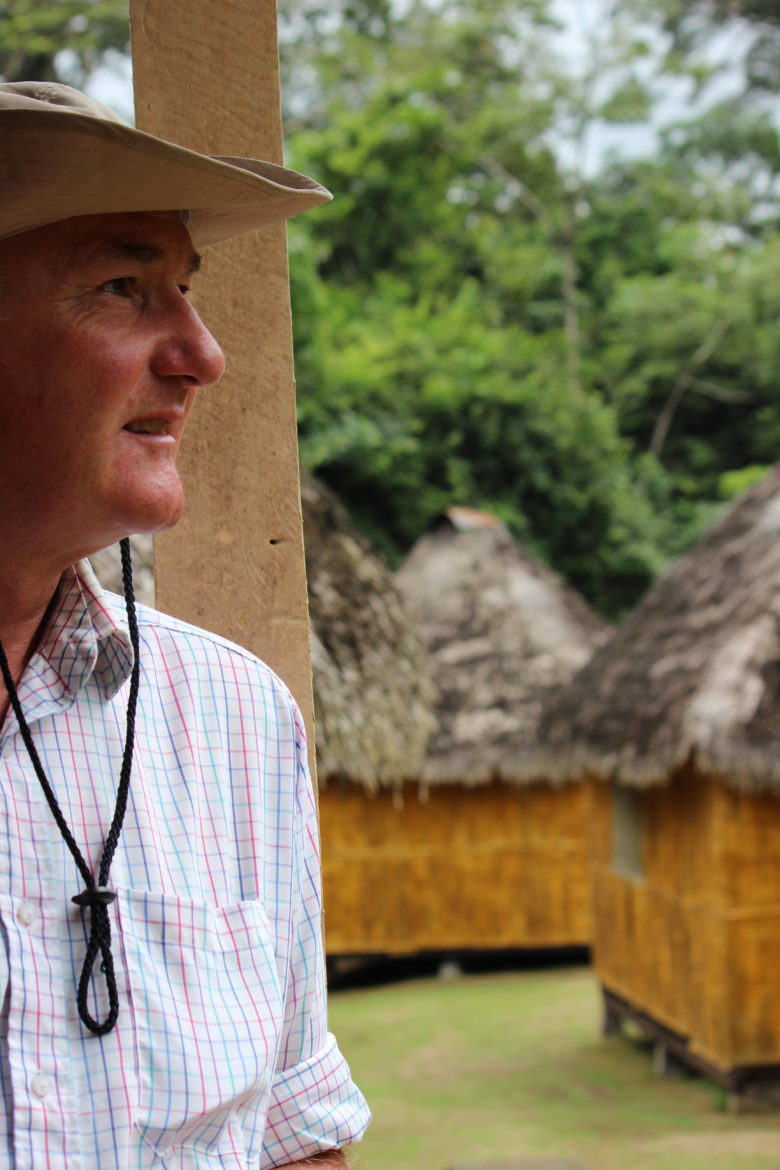On the Road to Guayaquil
12th April 2016
Yesterday we left hot & humid Bahia in a Reina Del Camino, Queen of the Road coach passing donkeys grazing the roadside towards Guayaquil. Cattle grazed in fields, each with their single white egret companion. Plump horses and more private car ownership suggested a more affluent population than near the coast.
Stalls were scattered alongside the road on our 5 hour journey, complete with stainless steel gas ovens, where individual portions of local food were cooked to sell to passers-by. A man with basket full of fried mashed yucca buns filled with cheese came aboard and we each tried one. They were hot, tasty and filling.
In our room in the Hampton Inn Hotel in downtown Guayaquil we found all our clothes were damp from the humid atmosphere on the coast. We didn’t notice then because we also were damp. We soon had the room looking like a Chinese laundry as they dried off!
After dark we walked along the Malecon 2000 (waterfront) which reminded me a little of the Bund in Shanghai. Police and security guards everywhere made it a safe place for families with children of all ages. We took a good look at a fine square rigger before wandering home to the sounds of “agua agua” from the numerous water sellers. No one drinks the tap water here.
Today we got to grips with the list of things to do and visit supplied by a charming tourist adviser we found in a museum of modern art. Life size models of contemporary people and their activities stood and sat in front of superb pastoral colour and black and white photos of folk.
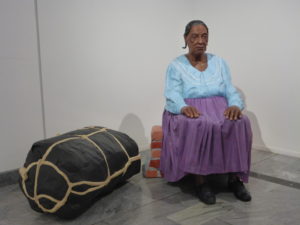
Our first port of call was the park full of Iguanas. They are such trusting and placid creatures, even when a father let his child hold up its tail the Lizard could have whipped it away, but it didn’t move.
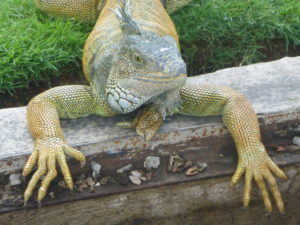
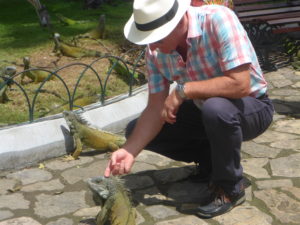
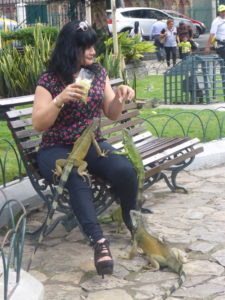
We made short work of the lovely light cathedral before walking to the old part, Santa Ana hill and climbing the 444 steps to the lighthouse and chapel on the top. Fine views of course, muddy rivers full of strips of water hyacinth flowing up with the rise and down with the ebb tide, egrets balancing precariously on top.
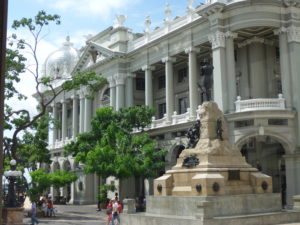
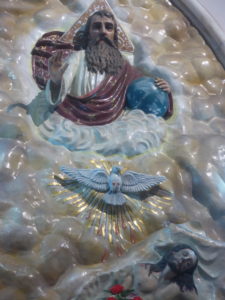
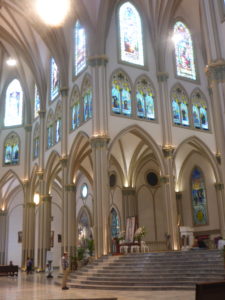
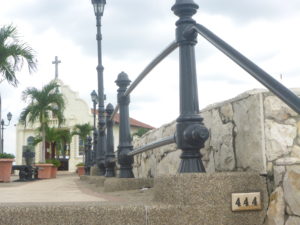
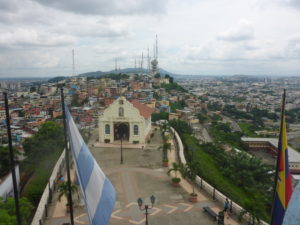
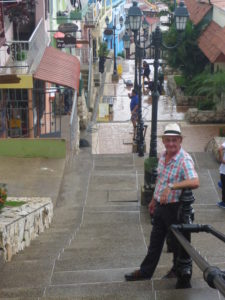
In a bar on the way down men were busy demolishing a wall and a very old man carried plastic barrels of rubble through the bar and threw it out of the window. The Pilsner beer was useful in washing the dust off our teeth!
Guayaquil is in a state of transition towards mass tourism and they need more quality restaurants. On our first evening we ordered pizza in a Pizza Hut, which was nice but there was very little choice on the menu. We’d have preferred some salad instead of the free pizza we were inexplicably given. As we ate a little girl came and watched us through the grill while her wheel chair bound father sold lottery tickets outside to make a tiny income.
As we walked the few doors back to the hotel, we saw her again and Rob leaned forward, offering her the pizza in its box. With big brown trusting eyes and an innocence as yet unspoiled by her street life, she slowly took the pizza from Rob’s hands.
13th April
A 15 minute taxi ride took us to the Historic Gardens, established to include pre-existing mangrove swamps. Fabriolo showed us native birds, spectacled caiman. Yep that’s what slithered into the river as we paddled over it in our inflatable canoe in the Las Perlas islands.
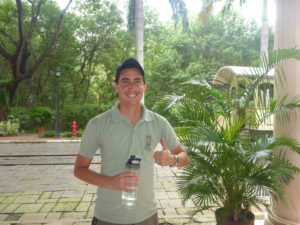
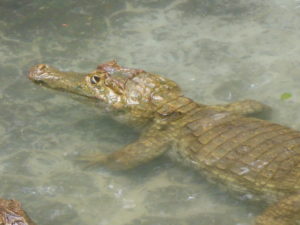
A sloth obligingly woke up and moved so we could get a photo and we were among the first to see a new born capuchin monkey clinging to its mum.
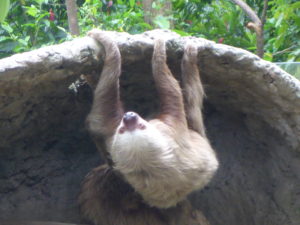
Fabriolo left us for a few minutes so we could enjoy a bollo; peanut, plantain and tuna, deliciously spiced and served in a banana leaf with boiled rice to accompany it. Then he showed us typical 19th century wooden houses, very similar to colonial ante bellum homes to be found on plantations in the US, or haciendas as farms are called here.
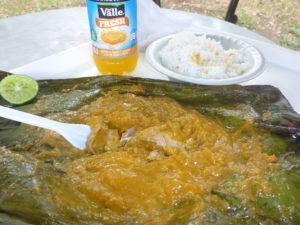
One of the houses that had belonged to a doctor and his family of 11 children, was painstakingly moved here from its original site facing the river front at the bottom of our hotel street to make way for the tallest high rise in the city which stands on exactly the same footprint. It was a big, beautiful home and is now used for functions especially weddings.
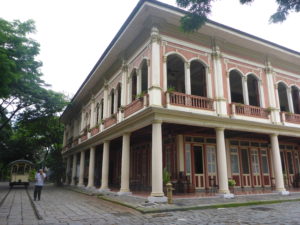
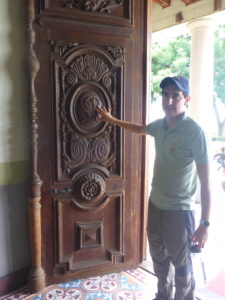
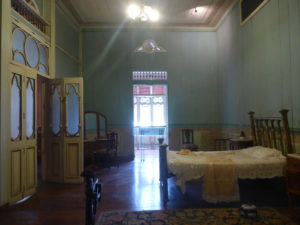
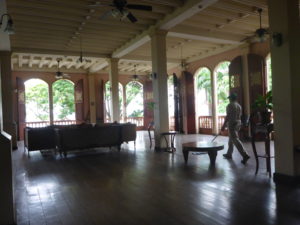
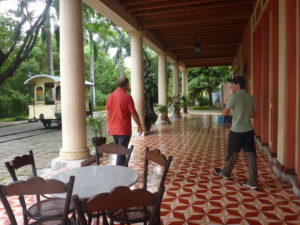
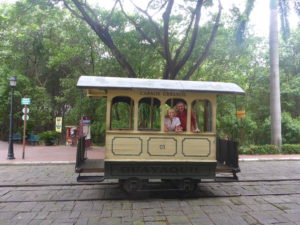
Back on Santa Ana hill we whizzed through the Pilsner museum, the music museum and we peeped into the football museum, all free and conveniently located in the same, brand new building in the old port area.
Rob’s clip on sun glasses had broken in transit and a very capable young lady in an optician’s office in the middle of a busy artesan market glued a tiny strip of thin wire on to link the lenses and refused to accept a fee. When Rob mouthed a grateful kiss she blushed.
We ate supper in an Ecuadorian restaurant, Cocolo. I had ceviche for the first time. A warm clear soup of raw red onion and tomato with cooked shrimp and lots of lime juice, it was delicious, but Rob’s thin steak in a cream sauce could have come from anywhere and looked unappetising.
14th April In Cooler Quito
Now we are relaxing in our hotel room in cooler Quito, 9121 feet up in the Andes, the second highest capital in the world. The highest is La Paz in Bolivia and the 3rd highest is Mexico City.
From our enormous windows we look towards a foreground of skyscrapers and background of the mountains and tomorrow we are off to the Amazon.
Stalin drove us to Quito airport from the hotel down the steep and bendy Ave de Conquistadors, the entry route of the invaders over 400 years ago. A few minutes onto the 3 year old motorway and beyond us, in the far distance rose the beautiful snow-capped Cotopaxi, (coto-neck and paxi-moon) because at the solstice the moon sits on it like a head. It is the highest active volcano in the world when measured to the centre of the earth.
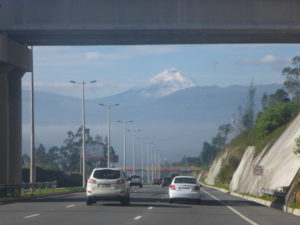
Thirty five minutes after take-off we landed at Coca airport 100 miles east of Quito and much lower down. The air was humid once more as we waited at the Quay to board the 16 metre twin outboard engine canoe with Pedro at the helm.
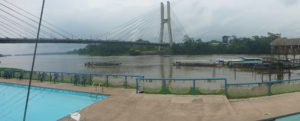
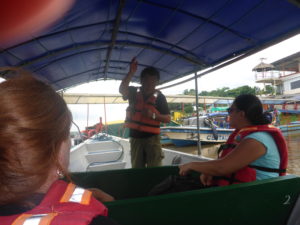
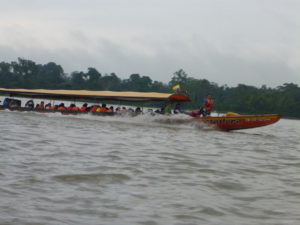
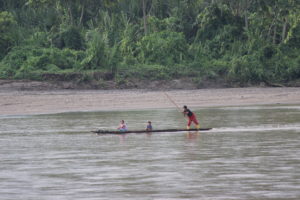
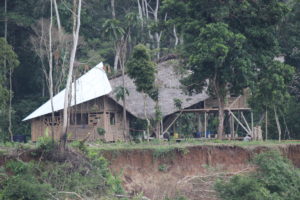
Coca was a sleepy little Amazonian port back in the 70s then oil was discovered and in the 80s the population rose to 50,000. Oil prices fell in the 90s and again recently as we know so many people have already left.
The hotel at the quay is fine with swimming pools etc. but both hotel and pools are permanently empty.
We sped along at what seemed a fast rate until one of the enclosed oil personnel launches overtook us rapidly on its way to the field. Raoul our guide told us that out of the three exploiters of the jungle, mining, lumber extraction and oil the latter is the least intrusive as the oil is passed by pipelines that have been sunk below ground and soon covered by undergrowth.
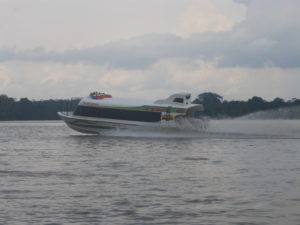
The water is pale brown with mud and full with tree trunks and sand banks. Pedro snaked us towards the Manatee and occasionally we would stop so he could clear the propellers of weed and branches.
The banks of this Amazon tributary, the Napo River, are thick jungle from the shorter growth rising to bamboo, palm and balsa to name but a few and behind, standing shoulders above the rest the lofty fig trees and very occasionally, a kapok tree, the tallest of all, with a vast perfectly domed canopy spreading from its thick trunk, like the tribal wise man of the trees. Useful for stuffing life jackets in the past.
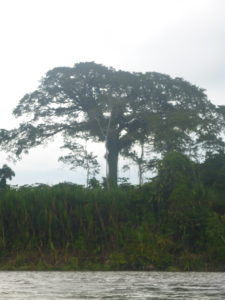
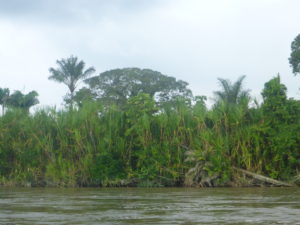
The Napo basin extends into Peru and is one of the greatest bio diverse areas in the world.
Finally, hair fixed horizontally after the speedy ride, we rounded a bend for our first glimpse of the Manatee, a 35 metre river boat who along with her bigger sister, the Anaconda, are the only live aboard Ecuadorian river boats.
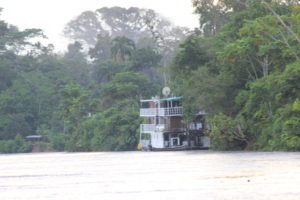
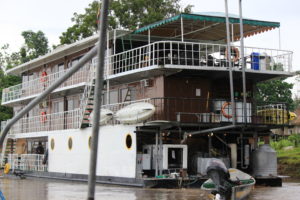
She can take 30 explorers but we were just five, Marcel and Andrea left their two young children at home in Guayaquil and Norma is from Mexico and speaks perfect English after being an au pair for a Cambridge Don years ago.

As soon as we boarded our short term home our captain eased her from the muddy bank she was glued to and we set off east while Juan Carlos the black bearded ship manager talked with us about routines and arrangements.
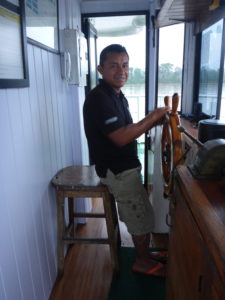
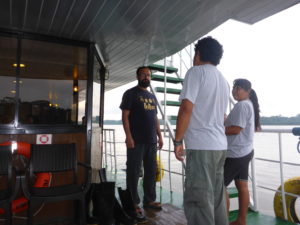
All the meals we had on board included fish, fruit and vegetables from the homes of the Kichwa natives who live and farm on their ancestral, riverside land. Some of the Kichwa crew, husbands and their wives ran the kitchen, boatwork and housekeeping on board.
In the fading light we approached the bank once more as it is not safe to travel at night with all the obstructions in the water. A crew member ran along a fallen tree and attached the bow line around a black stump for the night.
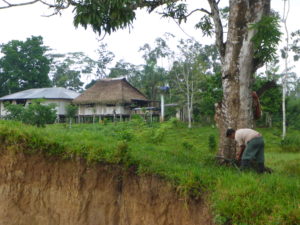
Beyond the Black Stump.
The wet muddy bank was vertical and we clung onto protruding roots to climb to the top. We were entering a farmer’s field and Raoul pointed with his torch to yucca and bamboo shoots randomly planted by the women and children.
Cicadas chirruped and we could hear a frog croaking as we crouched, bent double, to pass through a tunnel of matted branches. Without our head torches the only light was from the moon way above the canopy. Whoosh, and bats flew straight past us. Rob found a big female grasshopper, brown and full with eggs.
We walked for an hour or so and scrambled back down the bank to the canoe which had been waiting to take us back for our first night on board.
0.29.5S 76.17.33W 700 feet above sea level on the Amazon.
The rumbling thunder of the night before continued in the distance beyond the trees as we sped down river towards the mouth of another Amazon tributary, the Panacocha. A community centre on the left bank comprised school rooms, a community hall, teachers’ homes and some native Kichwa homes. We were to visit such a community later on.
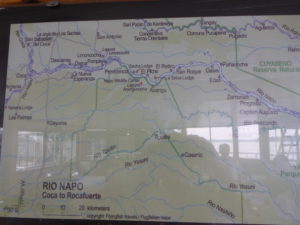
A marked line separated the pale brown, silty Napo river water from the clear and dark brown brackish water of the smaller Panacocha, full of tannins.
Within minutes Raoul, our guide had spotted a two fingered male sloth with an orange dot on his back, high in a fig tree. How did he know it was male I wondered? They eat only leaves and as there is little nourishment in leaves they move very slowly. They are predated by the harpy eagle. On route we spotted weaver birds and their purse like nests hanging from the trees like drop earrings, kingfishers twice the size we are used to, toucans in flight and several different types of herons.
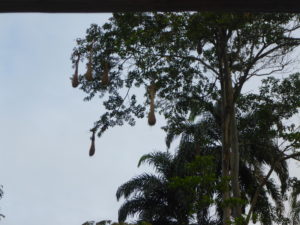
Howler monkeys complained vehemently about the rain and vibrant blue male Morpho butterflies flew low over the water on both sides of us. The dull coloured females fly over the males to check out who is perfect in wing and body before deciding on their mate.
The form was set, as soon as we heard a sound we looked to Raoul for an explanation and his knowledge was thorough.
The river fish live on the numerous types of fruit that fall into the river. Rob noticed some long nosed bats clinging onto a fallen branch in the river. They flew off as we had strayed into their comfort zone. Bats and stingless bees are essential in the forest as they fertilise the plants and trees.
Birds play their part too. When they poo in the trees seeds become lodged and in the moist warm atmosphere cannot help but grow. An example is the philodendron which sends long soft roots called lianas to the forest floor to ensure a water supply. Other ground placed plants then send their aerial roots up the soft lanes and eventually harden. Buttresses in the making.
As we entered Piranha Lake thunder was still rumbling around the trees and the ground was muddy for the walk up to Dolphin Lodge which would be our home for the next few hours. The crew from the Manatee disappeared in to the kitchen to prepare lunch while we went for a stroll in the forest.
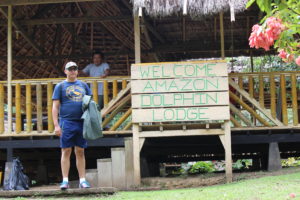
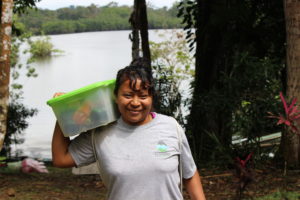
We found a fresh tapir footprint, and Raoul explained that bats bite in a straight line across the veins of a wide green leaf so it bends double and they can hang underneath their umbrellas out of the rain.
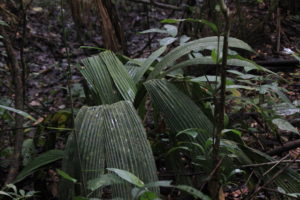
I wondered what happened to the little leaf carrying ants when it rains. Well they run home as quick as they can and never pick up the same leaf fragment again as it is dirty. Tiny specialist ants on their backs check the quality of the leaf before the journey home resumes.
Raoul showed us many plants that are used for medicine, building materials, weaving twine and fruits that once the pulp is eaten are hardened in the fire and used as cups and bowls.
The holy men of the forest, Shamans, are now virtually extinct but they used to accurately diagnose illness using leaves and guinea pigs and then prescribe treatment. The natives still grow and use medicinal plants although the Ecuador government has provided medical centres for more serious illnesses.
We were hot and sticky on our return to the lodge and when Raoul said “Anyone for a swim?” We couldn’t resist. We changed and slid down the path to the canoe. Splashing about in the middle of a lake of piranhas, the thunder rumbling, howler monkeys complaining, red bellied macaws flying overhead and black vultures watching us from the tree tops had a certain jungle magic to it.
We were ready for the delicious lunch dished up by Pepe at the long table beneath the bamboo and palm leaf roof. Soft sweet palm hearts, baked potatoes, barbecued veg pasta and fish was followed by home cooked doughnuts in caramel sauce and water melon.
We were still wet from the rain on our cool return in the canoe, passing the bats that must have been fast asleep as they didn’t budge. Long tailed black birds with a blue fluorescence like our starlings, Anhingas flew away from us and multi coloured, crested Hwatzin displayed to each other.
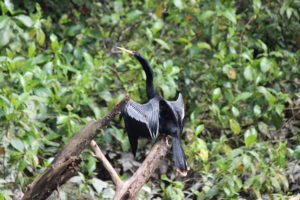
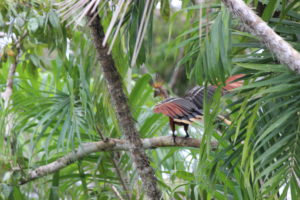
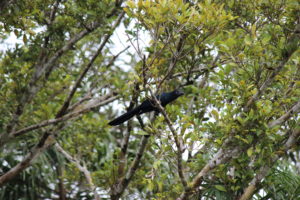
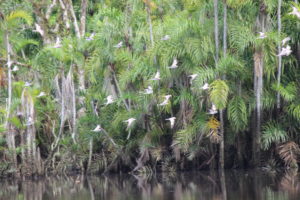
Back on board a young lady greeted us with a mug of delicious hot chocolate with cinnamon and tiny buns with banana centres.
As we sat together over a supper of yucca chips, fish or beef and lentils followed by local strawberries and cream we were more than satisfied with our day of adventuring.
We knew nothing of the earthquake that was to cause such tragedy and devastation and happened in the coastal lowlands to the west, until breakfast time the next morning when Andrea asked, “Have you heard?”
16th April Terremoto Day.
Many times Rob and I have marvelled at modern communication technology. We can keep in touch with you all from the middle of an ocean and talk with you by mobile phone from the bar in an Ecuadorian yacht club while looking at Zoonie moored mid river. We have never taken it for granted. Which is why we know we must now wait patiently until the lines of communication into the devastated area are restored and we will learn how Bahia has fared and whether we still have our lovely marine home.
It seems odd that Zoonie went through a powerful series of earthquakes without us.
The Kichwa way of life.
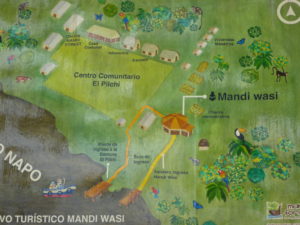
When the Spanish arrived they couldn’t believe there were no prisons in Ecuador. The Kichwa people for a typical example, keep their children very close to them. In fact in what we saw of Ecuador parents carry their babies and young, they don’t own prams or push chairs.
Kichwa children attend school from age five and learn their own language and Spanish plus other subjects. However the boys still learn to hunt with blow pipes and the girls learn to cook and weave baskets and make jewellery and are proficient with a machete from the age of eight.
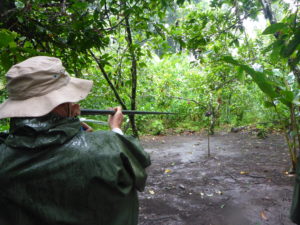
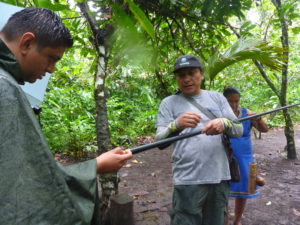
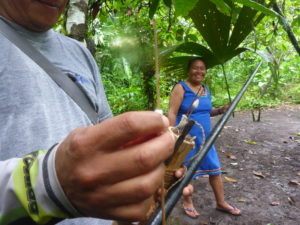
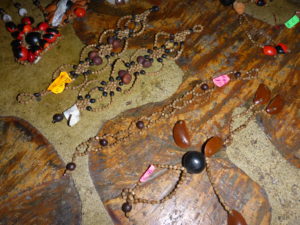
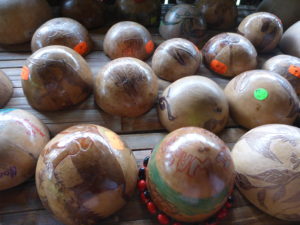
Some young Kichwan people finish school and straightaway start to teach in their own schools under the tutorship of an experienced teacher for two years.
If children are naughty they are warned but the next stage is a strike with a poison ivy branch. If adults misbehave it’s the poison ivy plus cold water in front of the gathered community at the community centre, ‘ouch’ but effective.
Some Kichwans leave their homes for the city but of late it has been hard to find work. They define poverty as a day without food. At home there is always plenty of food because the families grow it. Consequently there is a healthy multi aged population thriving in these happy, isolated groups.
Not that they are averse to modern ways. To raise money for supplies from Coca like beer and clothes the women have been helped by the government to set up small tourist businesses showing visitors how they live. This is a step forward considering how conservative their menfolk have been.
Berta showed us around wearing her blue sleeveless dress uniform. She has nine children and talked in Kichwan while Raoul translated. She was quietly proud of her heritage and by the time we had peeped into the class rooms and shuddered at the thought of cutting the football field at the centre of the community area with the machete she so deftly sharpened on a stone, we were well in to learning more. In the cleared vegetable area Berta told us how her grandchildren help her plant yucca cuttings but she has to go around again after they are asleep and turn some the right way up!
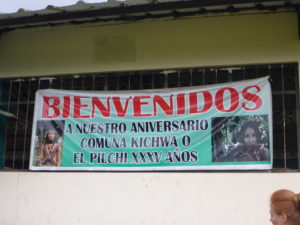
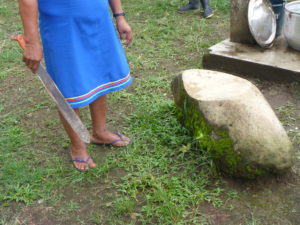
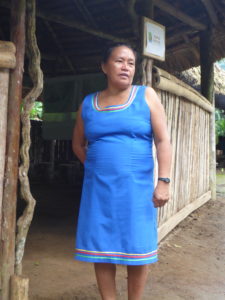
The men hunt peccaries, pigs and monkeys, pretty much anything that moves using blow pipes and I was right when I commented that the pipe appeared to be wrapped with black self-amalgamating tape. The tips of the needle thin arrows are dipped in a muscle relaxant poison taken from numerous tree types. First the brain is numbed, then the limbs relax and finally the heart gives out.
Finally we went into the replica home. I was relieved we weren’t visiting their real home as it is such an intrusion in my view. All the other women there were in red dresses the same style as Berta’s and were busy cooking or attending the tables covered with their beautiful hand-made crafts.
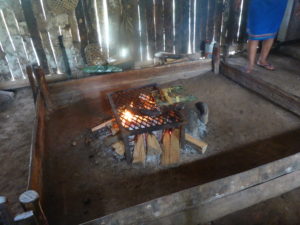
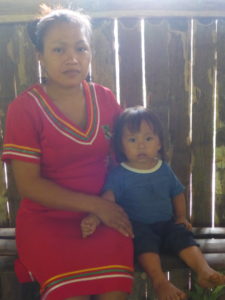
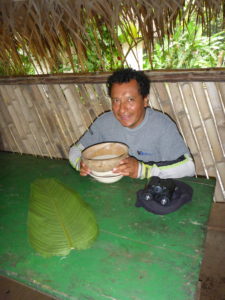
We were first treated to Chica, a drink made from vegetables such as the yucca tuber, ground up in a mini wooden boat and fermented with sweet potato. In days of old the women would chew the pulp to create a fermentation but we were relieved that today they leave it to the yams. On day one and two of the fermentation the children are allowed to drink this not unpleasant textured beer, but after that it achieves 2-3% alcohol so they give the children something else like their nice tea that tastes and smells smoky like lapsang souchong.
There isn’t a big problem with alcoholism because unlike the North American Natives who were poisoned with rum from the Caribbean, the beer they make is not dissimilar to the beer they buy.
To support them and as a memento we bought a calabash bowl with shiny red and black seeds around the rim. We spotted it as we admired their skilled handicrafts while eating a typical lunch from a wooden plate. Palm stem, fish, a crunchy fruit and a big fat roasted ruddy brown grub. OK so that sorted out the men from the boys. I unhappily (!) could not eat mine as I’m piscarian but Rob chewed through his and so did Marcel, hats off to you boys!
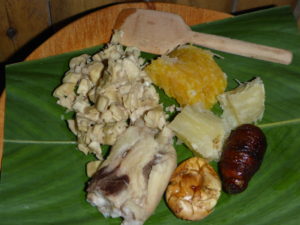
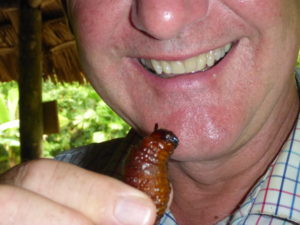
Earthquake News
Back on board the full scale of the earthquake damage was being shown on the TV and we feared not only for Zoonie but also the people of Bahia who had so quickly become our friends after our arrival. Bahia is only a few miles from the epicentre of the terremoto and we now know 11 people died and numerous buildings have collapsed including the home of marina manager Juan.
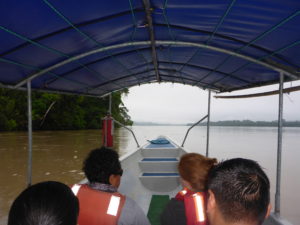
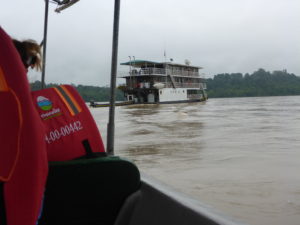
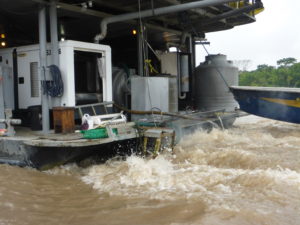
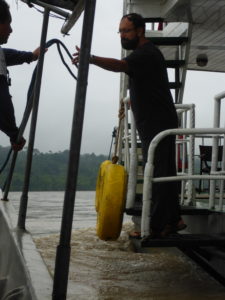
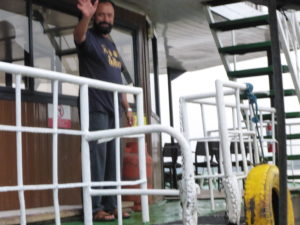
Marcel and Andrea were understandably worried about their children in Guayaquil even though they knew they were OK they could not be sure there wouldn’t be another quake or after-shocks. So they chose not to join us on our last meander through the jungle.
The splash we heard could have been an otter, there are giant ones around here, or a dwarf caiman. Many of the forest animals are timid and elusive. Raoul told us that nocturnal cameras pick up deer, black panthers, jaguars, tapirs and peccary in abundance but we were satisfied just to see their tracks, especially the big pussy cat ones.
We spotted a leaf toad, a relative of the Australian cane toad, so well camouflaged I couldn’t get a sharp photo and a bright green lizard hiding under a leaf.
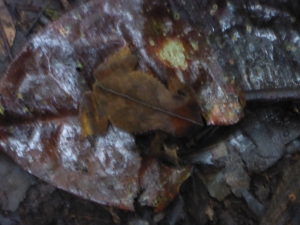
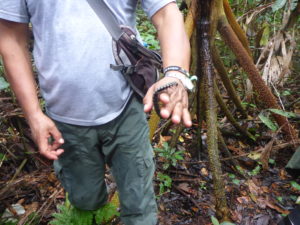
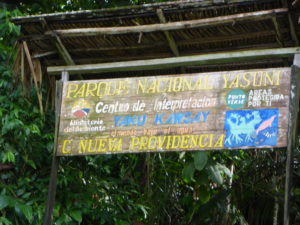
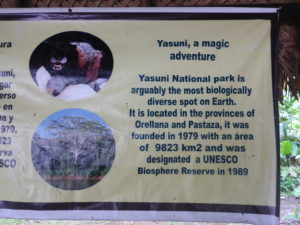
Raoul took hold of a long green stem with a round cross section and shook it vigorously. It separated into a fan of long pale yellow, centimetre wide fronds, “and this is what Panama hats are made from!”
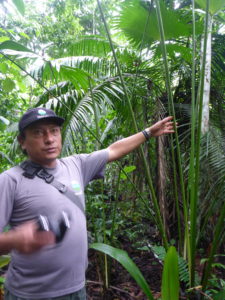
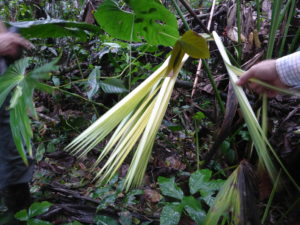
Eventually we emerged into a clearing where the large thatched huts of the Yakukawsay Kichwa Centre had been built as an educational experience. One was full of carved life sized examples of the indigenous animals. The manatee is now endangered with only 26 left in Ecuador but the river turtles are being farmed and returned to the wild in big numbers by the locals possibly because they are highly edible.
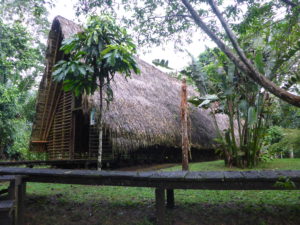
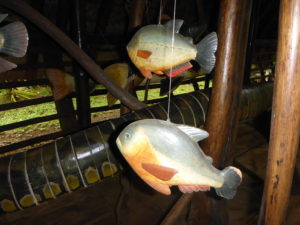
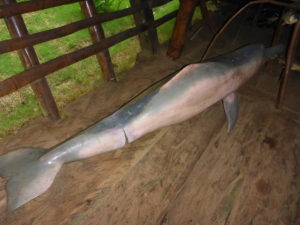
Raoul led us down-hill to the creek and the wooden canoe that would return us to the Napo shore and our big canoe. A shy young lad paddled at the stern while Raoul worked away at the front. We saw some of the same species I have already mentioned but as darkness fell we could just make out bats feeding on fish from the water around us.
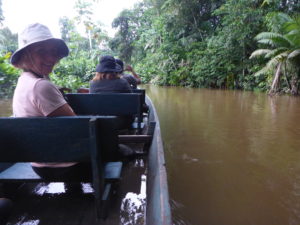
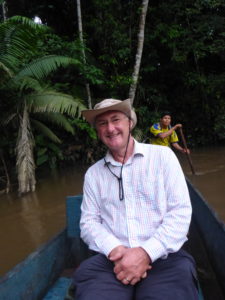
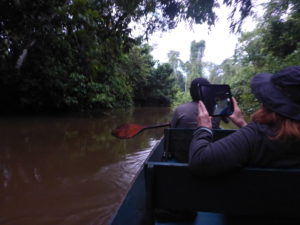
Back on board the ambience helped keep our spirits up and we enjoyed another delicious meal prepared on board from local produce before Juan Carlos presented us with our Amazon Explorer Certificates and Raoul gave us a slide show of the weekend.
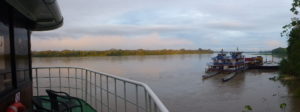
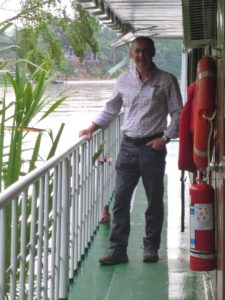
It was a fine experience, deep in the jungle with a lovely group of people passionate about the area.
Good news in Quito.
Back in our hotel room in Quito we tried to get through to Bahia but were unsuccessful so we asked our tour organisers in London if they could help. They got in touch with their representative company out here, Andean Travel Company, who phoned us this afternoon to say simply that Zoonie is safe and there is little damage to the yacht club, perhaps being built on stilts set in the river bed helped.
We relaxed for the morning as we have both picked up jippy tummies from somewhere, could have been any one of a hundred places. So while the policemen and women whistle the traffic past we studied the town map to see what to do later.
A taxi ride took us to the Carolina Gardens. Like Hyde Park it is a vast area of grass and trees where hundreds of folk were relaxing. A busy collection point was taking in donations to the earthquake appeal.
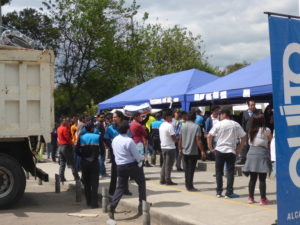
We wandered around the lovely botanic gardens then after a bit of a search found the tiny vivarium where we stood nose to nose with our first real Anaconda and eyeballed a dwarf caiman. They were in small tanks but I guess it is one way to see the jungle creatures and the little children that were looking around with us were engrossed pointing to a tank resident and then looking at us with big smiles.
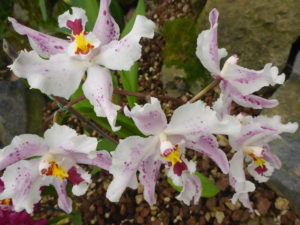
We had been to the old town the day before and felt uncomfortable in the overcrowded claustrophobic square. Second to that we went to a smart, modern cafe where I ordered a vegetarian sandwich and iced tea. No iced tea and the sandwich should have been cheese, tomato and avocado on pesto spread wholemeal bread. The bread was white, the cheese processed and the avocado absent. I felt like pointing out to the waitress the little girl outside selling tubes of yummy looking avocados. I was not impressed.
Today has been better although Rob’s tummy is still upset. By happy coincidence it has been one of the best days of the year to climb 4000 feet in the cable car up to the Pichincha volcano at 15,715ft. With its amazing views over the entire length of the city encircled by the Andes all around.
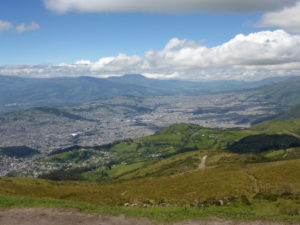
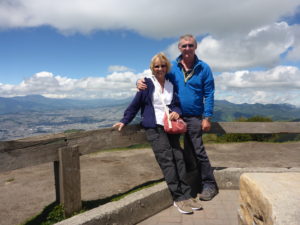
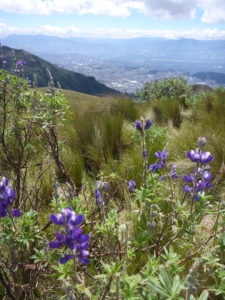
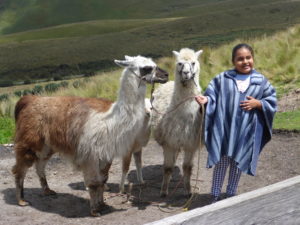
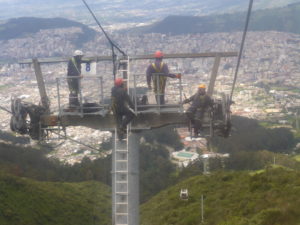
We revisited the pleasant terrace at the hotel and played cards as we chatted and supped beer, not the chica variety just plain old Pilsner.

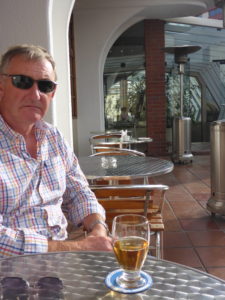
Tomorrow morning we rise at 3.50 to meet our tour rep for a ride back to the very new Quito airport and our two hour flight to Lima, with our hearts and minds happier than they were.
